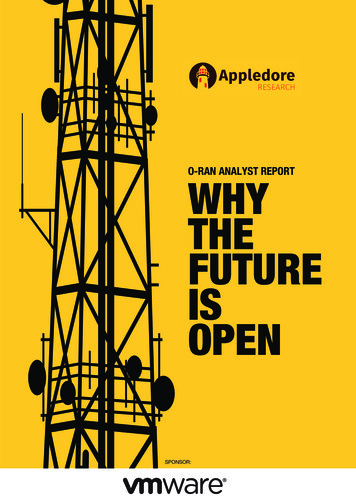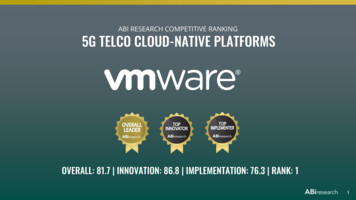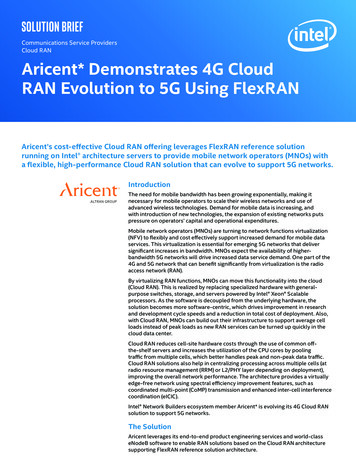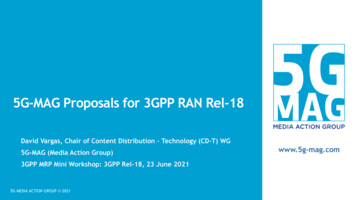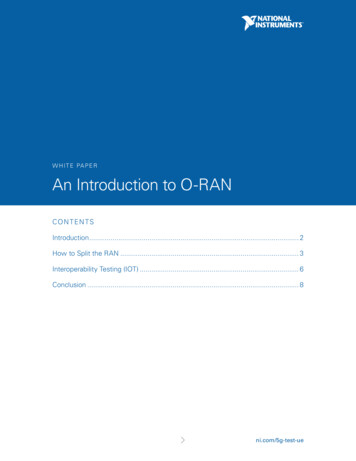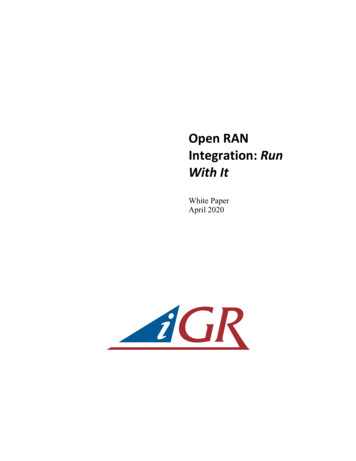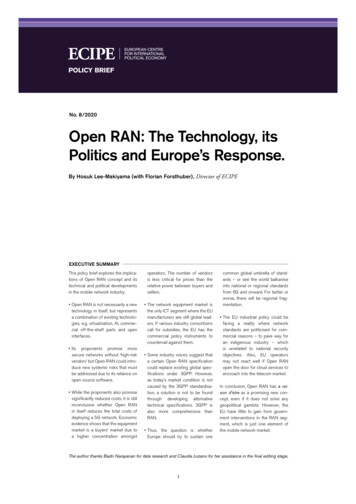
Transcription
ecipe policy brief — 7/2020POLICY BRIEFNo. 8/2020Open RAN: The Technology, itsPolitics and Europe’s Response.By Hosuk Lee-Makiyama (with Florian Forsthuber), Director of ECIPEEXECUTIVE SUMMARYThis policy brief explores the implications of Open RAN concept and itstechnical and political developmentsin the mobile network industry.operators. The number of vendorsis less critical for prices than therelative power between buyers andsellers. Open RAN is not necessarily a newtechnology in itself, but representsa combination of existing technologies, e.g. virtualisation, AI, commercial off-the-shelf parts and openinterfaces. The network equipment market isthe only ICT segment where the EUmanufacturers are still global leaders. If various industry consortiumscall for subsidies, the EU has thecommercial policy instruments tocountervail against them. Its proponents promise moresecure networks without ‘high-riskvendors’ but Open RAN could introduce new systemic risks that mustbe addressed due to its reliance onopen source software. While the proponents also promisesignificantly reduced costs, it is stillinconclusive whether Open RANin itself reduces the total costs ofdeploying a 5G network. Economicevidence shows that the equipmentmarket is a buyers’ market due toa higher concentration amongst Some industry voices suggest thata certain Open RAN specificationcould replace existing global specifications under 3GPP. However,as today’s market condition is notcaused by the 3GPP standardisation, a solution is not to be foundthrough developing alternativetechnical specifications. 3GPP isalso more comprehensive thanRAN. Thus, the question is whetherEurope should try to sustain onecommon global umbrella of standards – or see the world balkaniseinto national or regional standardsfrom 6G and onward. For better orworse, there will be regional fragmentation. The EU industrial policy could befacing a reality where networkstandards are politicised for commercial reasons – to pave way foran indigenous industry – whichis unrelated to national securityobjectives. Also, EU operatorsmay not react well if Open RANopen the door for cloud services toencroach into the telecom market.In conclusion, Open RAN has a raison d’etre as a promising new concept, even if it does not solve anygeopolitical gambits. However, theEU have little to gain from government interventions in the RAN segment, which is just one element ofthe mobile network market.The author thanks Badri Narayanan for data research and Claudia Lozano for her assistance in the final editing stage.1
ecipe policy brief — 8/20201. INTRODUCTION: WHAT DOES OPEN RAN IMPLY FOR THE EU?The realities of geopolitics affect no industry as much as the 5G network equipment market. Asmobile networks become the critical infrastructure that underpins all other infrastructures uponwhich societal functions depend, 5G networks serve as the backbone of societal or technologicalconcepts like smart cities and autonomous cars that will radically change the future.Several jurisdictions – including the US, EU Member States, Japan, Korea, Vietnam, and otherAsian countries, and not least China – have taken steps to limit the participation (de facto or dejure) of vendors associated with elevated levels of risks. In particular, the radio access networks(RAN) or 5G New-Radio (5G NR) that make up the radio installations ‘in the field’ havebecome at the centre of a political discussion. 5G raises new security issues and vulnerabilitiesthrough the RAN that were not deemed critical under previous generations of mobile networks.1RAN also accounts for the majority of equipment investments in a mobile network, as operatorsdeploy thousands of base stations across vast areas. It is in this particular network segment whereChinese vendors like Huawei and ZTE have thrived. Thanks to their ability to export by leveraging on the economy of scale thanks to the protected market in China, vendors like Huawei andZTE are exporting competitive RAN equipment that has challenged established suppliers likeEricsson of Sweden and Nokia of Finland.The current US-China economic decoupling and technological bifurcation in the networkequipment industry raises concerns about long-term market prospects and future supply. European operators also are concerned about rising costs, if fewer equipment suppliers may servethem. Strangely, this worry about supplier diversity has not a been prominent in Australia, Japan,outside of Europe. There are also new market entrants like Samsung, NEC and Fujitsu.2 In othermarkets, like the US, UK or India, the debate emphasises the need for indigenous (i.e. non-European or Chinese) producers rather than diversity of suppliers.3It is within this context which Open RAN technology has emerged in the debate: Open RAN isnot a new technology in itself but a concept that leverages on recent developments that allow fordisaggregation of hardware and software components into smaller parts, and virtualisation andAI that allows RAN functions to be performed in the cloud. Advocates of Open RAN promise lower costs and new suppliers coming into the unattractive RAN market, which has beenplagued by massive R&D costs and low profit margins.The many industry groups and consortia are turning into a plethora of acronyms: O-RAN Alliance a merger between xRAN Forum (formed by US tech industry) and C-RAN Alliance, consisting of mainly Chinese telecom operators. Telecom Infra Project (TIP) OpenRAN Project isled by Facebook.1Lee-Makiyama, H. (2018), Stealing Thunder, ECIPE, accessed at: http://ecipe.org//app/uploads/2018/02/ECIPE Occasional0218 HLM V7.pdf.2Koh, E. (2020), Samsung, Verizon Sign 6.65 Billion 5G Contract, The Wall Street Journal, September 7, 2020, accessed gn-6-65-billion-5g-contract-115994698833See inter alia Katoch, P. (2019), India’s 5G Network, Indian Defence Review, June 9, 2019, accessed at: network/ ; Schoff, J. and Kamijima-Tsunoda, R. (2020) The United States and Japan ShouldTeam Up on 5G, Carnegie Endowment for International Peace, July 23, 2020, accessed at: ates-and-japan-should-team-up-on-5g-pub-82354 ; Reuters (2020), UK Seeks Alliance to AvoidReliance on Chinese Tech: The Times, Reuters, May 28, 2020, accessed at: alition-idUSKBN2343JW ; Khan, D. (2020), Inside Reliance Jio’s Make in India Strategy for 5G, IoT to Cut Dependenceon Foreign Gear, The Economic Times Telecom, July 31, 2020, accessed at: tech-with-own-tech/745347772
ecipe policy brief — 8/2020Several US industry coalitions promise to further reduce costs by replacing the base stationsthat are today typically built by a single vendor (using customised code and high-performancechipsets). Their idea is to replace them with commercial off-the-shelf PC components and opensource software. The O-RAN Alliance aims to define new standards, and specifications for theOpen RAN concept using Intel chipsets, but its members also include Chinese telecom operators. Meanwhile, the OpenRAN Policy Coalition group is lobbying the US and other governments for preferential treatment for Open RAN, where some O-RAN Alliance specificationscould be adopted as national standards.4This paper argues that the Open RAN concept combines several technologies and features thathave been around for a few years already in 3G and 4G. Despite some teething troubles andinherent commercial limitations, a full-scale 5G RAN could be just a few test iterations away.Nonetheless, its commercial impact is limited in the short term –5 Open RAN may only hold asliver of the market, around ten per cent.6Also, Open RAN is not a silver bullet for any policy issues as it advertises itself to be. If it solvesthe security issue, or the market concentration arising from vendor exclusion policy, Open RANintroduces similar problems too. Nevertheless, the increasing government interventions in theRAN segment is a challenge for both telecom operators and equipment vendors, that are typically from Europe: In addition to the promotion of indigenous innovations in China, the USand India, cloud services are tempted to enter the operator market. Thus, it is somewhat unsurprising that the EU industries feel besieged by not one, but two Trojan horses.By politicising Open RAN, the standard-setting in the RAN becomes a catalyst for a bifurcationthat could end the global interoperability between the US, Europe and China that prevailedsince 3G.4Bill to use proceeds from spectrum auctions to support supply chain innovation and multilateral security by Senators Warner,Burr, Rubio, Menendez, Cornyn, Bennet in the 116th Congress 2nd Session in the United States Senate (2020), accessed at:https://www.warner.senate.gov/public/ ano, M. (2020), If Dish is America’s Rakuten, it Might be in Trouble, LightReading, October 5, 2020, accessed at: sts-/d/d-id/764411? mc RSS LREDT6Kapko, M. (2020), Open RAN Set to Capture 10% of Market by 2025, SDxCentral, September 2, 2020, accessed at: set-to-capture-10-of-market-by-2025/2020/09/3
ecipe policy brief — 8/2020Fact box: What is Open RAN?Mobile access network in the field are typically delivered by one single telecom equipment vendor like Nokia, Ericsson, Huawei, ZTE or Samsung within a local region. Since4G and onward, mobile operators have tended to consolidate the purchase of RANequipment from a single (or at most two) vendors for performance and end-to-endaccountability.Open RAN is an industry concept, or a philosophy – and not a technology. Open RANproposes an alternative way to design and build the RAN portion of a mobile networkby combining hardware and software components from different vendors. Thanks toopen and interoperable interfaces multi-vendor implementation is possible on a singlesite, going beyond today’s multi-vendor RAN deployment in different geographic areas.In particular, the O-RAN Alliance (a consortium led by US PC and software companies)is defining these specifications. However, RAN is just a portion of a complete mobilenetwork: Existing global standards and protocols developed under 3GPP are still necessary for all non-RAN part of mobile infrastructure, or to integrate them with an OpenRAN.Virtualisation also allows for 5G NR functionality (typically performed by physical andcustomised hardware) to be performed by software over the cloud. Given the increasedcomplexity of 5G networks, it is no longer viable for humans to operate and optimise amobile network and instead embed AI throughout for that purpose.However, interoperability, virtualisation, cloud and AI are all pre-existing technologiesthat by no means are unique to the Open RAN concept. These are also natural featuresin traditional approaches. RAN is already supplied by multiple vendors, albeit splitting anational network by regions, rather than on a single site.4
ecipe policy brief — 8/20202. DOES THE 5G CYBERSECURITY TOOLBOX REALLY NECESSITATE OPEN RAN?As 5G changes the way our society uses and relies on mobile data, it also increases the scopeand potency of cyber espionage. The commercial or public value of the information carried ina 5G network will increase multi-fold compared to today,7 with large-scale and critical machinecommunication containing more corporate information, trade secrets and critical applications.5G will be essential to government functions, corporations, individuals and society as a whole.The supplier restrictions on 5G infrastructure of recent months are rooted in how 5G architecture operates differently from previous generations. The wireless telecommunication networkconsists of several parts. But it is the RAN and its radio antennas and base stations (that connectsindividual devices to other parts of the network), which is at the centre of today’s discussions.The 5G RAN (also called 5G New Radio) will also account for the majority of a mobile operators’ capital expenditure on equipment.Previous security measures often involved restricting non-EU vendors from core networks (wherekey functions are performed) while they were allowed to supply the less sensitive RAN. However,the new 5G architecture will blur the distinction between RAN from other parts of the networkthrough virtualisation and mobile edge computing.In response, the new updated 5G restrictions have led to de facto or de jure exclusion of nontrusted vendors. Since the first 5G vendor-restriction – Australia’s Telecom Sector SecurityReview (TSSR) in 2019 –8 the United States, Japan, Korea, Vietnam and the UK have excludedvendors from China. The EU Member States are developing a common regulatory tool with mitigating measures where at least twenty countries are pending to take restrictive measures. Chinahas also limited the participation of European vendors to approximately ten per cent, excludingone vendor entirely.Whether Chinese 5G equipment is competitively priced thanks to non-market factors is more orless disputed by analysts. However, it is undeniable that Chinese vendors benefit from economiesof scale achieved in their home markets. After all, China continues to represent more than halfthe global 5G RAN market, and the four Chinese state-owned telecom operators promote localvendors. Thus, Chinese vendors achieve the scale to export into overseas markets in Europe andmany developing countries.Open RAN and securityIt is not the purpose of this paper to discuss the merits of recent vendor restrictions in the US,Europe, China and elsewhere. However, if one of the objectives of Open RAN is to provide analternative to vendors alleged to have legal and extrajudicial obligations to the foreign governments, then the new Open RAN technology must be more secure than today’s vendors.However, an open-source based Open RAN would present several security complications inaddition to the pre-existing risks of virtual network functions. One of the inherent security risksof open-source code is its public availability, including information on vulnerabilities availablethrough resources like the National Vulnerability Database (NVD).9 Hackers and advanced persistent threat groups (APTs) could exploit such vulnerabilities and target carriers that are known7Supra 1.8Lee-Makiyama, H. (2018), 5G and National Security, ECIPE, accessed at: final.pdf9Cypress Data Defence (2020), 3 Open Source Security Risk and how to Address Them, Medium, August 4, 2020, accessed curity-risks-and-how-to-address-them-82f5cc776bd15
ecipe policy brief — 8/2020to be slow to patch their applications. This inherent weakness of open-source, with the vast number of strategic applications on servers running Linux (which is open-source based), have madethem a common target for APT groups,10 with number of incidents 430 percent.11Also, Open RAN technology disaggregates and atomise a base station into different parts, e.g.radio, central and distributed units, where different vendors supply each part and yet fit togetherthanks to open front-haul interfaces. The continuous integration of highly specialised and discrete solutions will inevitably offer APT groups new opportunities to exploit vulnerabilities inwidely disseminated niche solutions.As the US government ‘discouraged’ its mobile operators from using Chinese vendors evenprior to the 2019 Entity List,12 the US networks were already ‘secure’ and built exclusively byEuropean and Korean suppliers. For Europe, Open RAN replaces today’s risks that are situation-specific – i.e. limited to certain suppliers in some countries – for a systemic risk stemmingfrom open source software and integration vulnerabilities of open-source that is still exploited bystate-sponsored APT groups.Therefore, it is essential that Open RAN adequately addresses security risks (in its standards, aswell as in its implementation), through a risk-based approach and not deal with security as aproblem that will be solved ex-post. The O-RAN Alliance is already addressing the new securityrisks through a recently formed security task force (within ORAN WG1 on architecture).13 Asthe O-RAN Alliance introduces additional open interfaces and functions that are not part of the3GPP standard. Therefore, O-RAN specifications will require additional security measures inaddition to the 3GPP SA3 security standards.In conclusion, there are two critical questions to be raised on security. Firstly, Open RAN onlydiversify vendors within a base station, while mitigating the risks on national RAN and data-intensive core networks must be achieved by traditional means.Secondly, Open RAN will inevitably introduce a new range of security issues, rather than solving those of the past. EU policymakers need to ask whether the legal risks of foreign-made basestations overshadows the omnipresent threat of software and integration vulnerabilities in OpenRAN, many developed by small (yet dominant) firms whose ownership are yet to be clarified.Hence, Open RAN on its own does not mitigate the supplier-specific risk identified by 5G EUToolbox.14 Also, the need to meet security objectives will inevitably limit the number of actualOpen RAN suppliers to ‘trusted stacks’ for software and hardware. Similarly, only a small groupof companies will be able to comply with the common security requirement compliant underthe O-RAN Alliance specifications.10GReAT (2020), An overview of targeted attacks and APTs on Linux, September 10, accessed at: cks-and-apts-on-linux/98440/11Chickowski, E. (2020), Next-gen supply chain attacks surge 430%, Dark Reading, August 21, accessed at: 8717? mc rss x drr edt auddr x x-rss-simple12Department of Commerce Bureau of Industry and Security (2019) Federal Register, 84(162), August 21, 2019, accessed 21/pdf/2019-17921.pdf13O-RAN Alliance (2019), O-RAN Alliance WG1 Operations and Maintenance Architecture v02.00, accessed at: an Commission (2019), Member States publish a report on EU coordinated risk assessment of 5G networks security,October 9, 2019, accessed at: /en/ip 19 60496
ecipe policy brief — 8/20203. IMPLICATIONS OF OPEN RAN ON 5G INVESTMENTSThe telecom carriers depend on their ability to scale revenues from users while driving downboth variable costs (e.g. the cost of servicing the customers, device subsidies, and the cost ofenergy and leasing cost of towers) and fixed costs (i.e. investments). Due to the modest averagerevenue per user (ARPU) in Europe (compared to other, more technology-embracing, regions),with the higher cost of associated with building stand-alone 5G networks (Release 16) despitetheir shorter range, 5G networks is not always a lucrative investment for European networkoperators. Bruno Jacobfeuerborn – Deutsche Telekom’s Head of Tower Business – believes thatRAN costs must drop by at least 50% to make 5G roll-out economically viable in Europe,claiming that RAN hardware accounts for up to 70% of these costs.15 The question is whetherthe Open RAN technology achieve such cuts.European operators are understandably concerned about costs if some principal players aredeclared ‘high-risk vendors’ (HRVs) and how it may lead to higher prices for RAN equipment.However, such discussions seem to be limited to Europe. The cost question is surprisingly absentin other markets where RAN vendors have been excluded on markets such as the US, China,Japan, Korea where at least one or two foreign vendors have been de facto absent. Even in smallerdeveloping countries like Vietnam, much smaller and less resourceful operators have decided toreplace some vendors.There are also new market entrants like Samsung (also followed by Japanese competitors likeNEC or Fujitsu) who have already made inroads into the US market,16 and could increase theirmarket presence in Europe. In China, minor Chinese companies such as Datang Telecom Groupalways held a corner of the local market.How the O-RAN Alliance aims to drive costs downIf virtualisation and other vital features of Open RAN centralise the workload away from the‘edge’ of the network, it allows for base stations that use cheaper low-performance chipsets. Hereis where Open RAN technology does not just promise new vendors – but also to significantlydrives costs down through the use of commercial off-the-shelf (COTS) parts made for the PCindustry.Open RAN-based COTS hardware yields high economies of scale as it is less costly than customised hardware R&D and could reduce costs significantly for the roll-out of 5G networks. Especially the members of the O-RAN Alliance aim to replace as much proprietary hardware as possible in favour of COTS to make widespread 5G roll-outs financially viable. The specifications ofthe O-RAN Alliance uses ‘Lego parts’ made by its US-based consortium members, including theworld’s largest vendor of PC-processors, Intel, with its software reference platform to run virtualRAN workloads with cloud virtualisation platforms provided by VMware and Dell.17However, COTS may not yet replace customised chipsets in critical low-latency applications.The setup is currently rolled out for LTE (4G), but yet not ready for 5G NR. So far, Intel-basedare unable to compete performance-wise with customised chipsets and other electronics in theproprietary baseband units by Ericsson, Huawei, Nokia and Samsung with processors that are15Morris, I. (2018), Major Telcos Pool Efforts to Slash 5G RAN Costs, LightReading, February 27, 2018. Accessed at: d/d-id/74091316Wood, N. (2020), Samsung Joins the 5G RAN Big Leagues With 6.6bn Verizon Deal, Telecoms.com, September 7, 2020,accessed at: an-big-leagues-with-6-6bn-verizon-deal/17Hardesty, L. (2020). VMware and Intel help Deutsche Telekom with O-RAN, Fierce Wireless, February 28, 2020, accessed and-intel-help-deutsche-telekom-o-ran7
ecipe policy brief — 8/2020designed specifically for their tasks. Meanwhile, high-end suppliers like Apple have abandonedIntel (x86) chipsets that have failed to deliver efficiencies it needs for its high-end devices.But a full-scale 5G Open RAN using only hardware and software by the O-RAN Alliance isperhaps just a matter of time. Results seem impressive so far, with promises of up to 50% savingson RAN hardware,18 although a breakdown of operator costs shows that savings does not leadto lower overall costs, if they lead to increased costs elsewhere, e.g. higher integration cost orenergy consumption.19 As a result, early Open RAN deployments indicate that they have not yetdelivered lower costs.20FIGURE 1: SIMPLIFIED SCHEMATICS OF TRADITIONAL VS ORAN VALUE-CHAINIntelOperatorSupplierNokia, ource: Authors’ analysisThere are, however, several outstanding questions. Firstly, it is unclear how much a Europeannetwork operator will save on the bottom line and total cost of ownership (TCO) of a network.The operators must either build up inhouse engineering capabilities or contract a system integrator who will do it for them.From the perspective of corporate finance, it is a transformation of hardware investments (i.e.capital expenditure that says on the balance sheet) into additional staff or consulting fees, i.e.operational expenditure that hits the income statement and cuts dividend payments.As of today, EU operators already find it too costly to comply with monoculture bans that requirethem to diversify into just two RAN equipment vendors (in addition to all other vendors. Ifmaintaining two traditional RAN suppliers within a country is too costly and complicated forthem, it is difficult to see EU operators embrace Open RAN with dozens of suppliers per site.Some consolidation is unavoidable, even with O-RAN Alliance specifications. As Open RANmatures over time, O-RAN Alliance may turn into just another vertically integrated vendor (likeNokia, Ericsson, Huawei or Samsung), albeit originating from the US, India or elsewhere.18See inter alia Hardesty, L. (2019). Mavenir wants to replace the proprietary baseband unit with x86 and software, FierceWireless, April 17, 2019, accessed at: oftware ; Supra 5.19GSMA Connected Society (2019), Closing the Coverage Gap, GSMA Association, July 2019, accessed at: 2019.pdf20Supra 5.8
ecipe policy brief — 8/20204. MARKET CONCENTRATION ON THE 5G RAN MARKETPrevious two sections draw on the concern amongst EU carriers that the supplier market evolvesinto a duopoly if new national security rules exclude high-risk vendors from the market. Similarconditions apply for the Chinese market, where one European vendor has qualified for the 5G‘pilot’ roll-outs organised in 2019. But are there real concerns for market concentration anddominant behaviour by the remaining vendors on the equipment market?It is indeed true that the mobile network equipment market has been characterised by marketconsolidation – which often (but not always) translate into more concentration. Duty-free tradeand the absence of regulatory barriers have unleashed unprecedented economies of scale. Withthe extraordinarily high R&D costs, the world has just four or five global players left in business– namely Huawei, Ericsson, Nokia, Samsung and ZTE. Notably, the North American suppliers of RAN – like Nortel, Motorola or Lucent – have all merged into the remaining Europeanplayers.Surprisingly, despite a complete absence of market entry barriers and close synergies with adjacent segments, only a couple of suppliers have decided to enter the RAN market, post-Huawei.Profit margins are typically lower than ten per cent and just half of the R&D spending. Networkequipment does seem like not an industry for rational people with other, alternative investmentopportunities.While some exclusively blame China’s entry into the market, there are also other factors at play.The telecom equipment market, given its high concentration of buyers amongst operators, isa market characterised by monopsonistic competition. In other words, there is a higher marketconcentration amongst the buyers than sellers.In all of the EU markets, there is a market dominance exercised by an incumbent player that isusually a former monopolist. Operators are also allowed to engage in different models of collusion. In the EU Member States, they form joint ventures with competitors to pool their procurement and management of their network infrastructure. In China, state-owned operators buyall their equipment jointly through a state-owned contracting agency to exercise price pressure.A buyers’ marketEvidence from European markets overwhelming shows that buyers, rather than sellers, set themarket prices. Network equipment is a buyers’ market. The number of vendors is less critical formarket prices compared to the relative power between buyers and sellers. As long as the marketentry barriers stay low, there will be enough pressure on hardware suppliers to offer competitiveprices, which is also evident from the low profit margins that plague the industry.Antitrust investigations typically illustrate market concentration through the Herfindahl-Hirschman index (HHI),21 which measures the market concentration on a continuous scalebetween 0 and 1, where 0.5 indicates a duopoly, and 1.0 indicates a full monopoly with just oneseller – and where the European network equipment market score less than 0.3.21See Herfindahl and Hirschman, (1993), National Power and the Structure of Foreign Trade, Berkley Univ. of California Press,1945; Rhoades, Stephen A. “The Herfindahl-Hirschman Index.” Federal Research Bulletin. 79 (1993): 1889
ecipe policy brief — 8/2020FIGURE 2: MARKET CONCENTRATION: OPERATORS VS RAN VENDORS (2019)0.60.50.40.30.20.10United StatesFranceGermanyOperatorsChinaVendorsSource: Author’s analysis based on Macrotrends.net and DellOro.comAcross all major world markets, telecom operators are either equally or more concentrated thanthe equipment vendors, indicating the monopsonic relationship. The relative strength of thebuyers is even more pronounced in reality, as the data on operators do not capture joint venturesor pooled procurement. In particular, the EU national telecom markets are far more concentrated when they act like buyers (against vendors) rather than as service suppliers.Also, market concentration is distinctively higher for operators compared to equipment manufacturers in Europe than elsewhere. In France, for example, the market concentration on theoperator market is equivalent to the level of a duopoly, nearly twice the levels of the vendormarket. In the US and China, the buyers and sellers are on an equal footing as one large vendor
encroach into the telecom market. In conclusion, Open RAN has a rai-son d'etre as a promising new con-cept, even if it does not solve any geopolitical gambits. However, the EU have little to gain from govern-ment interventions in the RAN seg-ment, which is just one element of the mobile network market. EXECUTIVE SUMMARY




